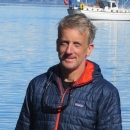Since start of production in 1978, Warm Springs National Fish Hatchery (NFH) has been managed with the goal of maintaining the stock integrity and genetic diversity of hatchery and wild spring Chinook salmon populations in the Warm Springs River, Oregon. The primary method identified to accomplish this is by regularly using wild fish in the hatchery broodstock broodstock
The reproductively mature adults in a population that breed (or spawn) and produce more individuals (offspring or progeny).
Learn more about broodstock . Due to low wild fish returns (<1,000 fish) in recent years, wild fish have not regularly been incorporated into the hatchery broodstock. The absence of wild fish in the hatchery broodstock greatly impacts the hatchery’s ability to maintain wild fish genetic characteristics in the hatchery population. In 2010 we evaluated the feasibility of using live-spawned wild males to provide a genetic contribution to both the hatchery broodstock and natural production by live-spawning five wild males and releasing the fish back into the Warm Springs River. Milt was collected from four of the five males, however the amount of milt collected was generally smaller (2-3 ml vs >10 ml) than during the typical spawning process. The five males were radio-tagged and released into the Warm Springs River to swim volitionally upstream of the hatchery. While one fish never left the hatchery ladder after spawning and tagging, the four other tagged fish migrated 21-30 rkm upstream of the hatchery. We concluded that these fish could have contributed to natural spawning in the Warm Springs River basin. Overall, it appears that live-spawning of wild males may be a feasible method to include wild genetics into the hatchery broodstock while not compromising the overall wild production, although the amount of genetic contribution to both the hatchery and wild populations was not quantified. A more comprehensive evaluation is needed before such an action can be recommended as a regular hatchery practice.
Doug Olson
Jens Lovtang
Trevor Conder
Publication date
Type of document
Report
Facility
Program
Species
FWS Focus
FWS and DOI Region(s)




